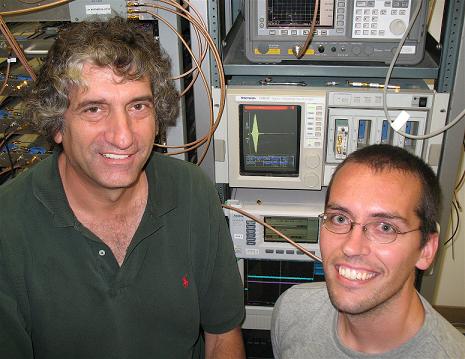Home > Press > Experiments at UCSB Push Quantum Mechanics to Higher Levels
 |
| John Martinis and Matthew Neeley in the lab. Photo: George Foulsham, Office of Public Affairs, UCSB. |
Abstract:
Scientists at UC Santa Barbara have devised a new type of superconducting circuit that behaves quantum mechanically -- but has up to five levels of energy instead of the usual two. The findings are published in the August 7 issue of Science.
Experiments at UCSB Push Quantum Mechanics to Higher Levels
Santa Barbara, CA | Posted on August 12th, 2009These circuits act like artificial atoms in that they can only gain or lose energy in packets, or quanta, by jumping between discrete energy levels. "In our previous work, we focused on systems with just two energy levels, ‘qubits,' because they are the quantum analog of ‘bits,' which have two states, on and off," said Matthew Neeley, first author and a graduate student at UCSB.
He explained that in this work they operated a quantum circuit as a more complicated artificial atom with up to five energy levels. The generic term for such a system is "qudit," where ‘d' refers to the number of energy levels -- in this case, ‘d' equals five.
"This is the quantum analog of a switch that has several allowed positions, rather than just two," said Neeley. "Because it has more energy levels, the physics of a qudit is richer than for just a single qubit. This allows us to explore certain aspects of quantum mechanics that go beyond what can be observed with a qubit."
Just as bits are used as the fundamental building blocks of computers, qubits could one day be used as building blocks of a quantum computer, a device that exploits the laws of quantum mechanics to perform certain computations faster than can be done with classical bits alone. "Qudits can be used in quantum computers as well, and there are even cases where qudits could be used to speed up certain operations with a quantum computer," said Neeley. "Most research to date has focused on qubit systems, but we hope our experimental demonstration will motivate more effort on qudits, as an addition to the quantum information processing toolbox."
The senior co-author of the paper is John M. Martinis, professor of physics at UCSB. Other co-authors from UCSB are: Markus Ansmann, Radoslaw C. Bialczak, Max Hofheinz, Erik Lucero, Aaron D. O'Connell, Daniel Sank, Haohua Wang, James Wenner, and Andrew N. Cleland. Another co-author, Michael R. Geller, is from the University of Georgia.
####
About UC Santa Barbara
The University of California, Santa Barbara, commonly known as UCSB or UC Santa Barbara, is a public research university and one of the 10 general campuses of the University of California system. The main campus is located on a 1,022-acre (4.1 km2) campus in Santa Barbara, California, 100 miles (160 km) northwest of Los Angeles. Founded as an independent teachers' college, UCSB joined the University of California system in 1944 and is the fourth-oldest general-education campus in the system.
From Wikipedia, the free encyclopedia
For more information, please click here
Contacts:
Gail Gallessich
805-893-7220
George Foulsham
805-893-3071
Copyright © UC Santa Barbara
If you have a comment, please Contact us.Issuers of news releases, not 7th Wave, Inc. or Nanotechnology Now, are solely responsible for the accuracy of the content.
| Related News Press |
News and information
![]() Researchers develop molecular qubits that communicate at telecom frequencies October 3rd, 2025
Researchers develop molecular qubits that communicate at telecom frequencies October 3rd, 2025
![]() Next-generation quantum communication October 3rd, 2025
Next-generation quantum communication October 3rd, 2025
![]() "Nanoreactor" cage uses visible light for catalytic and ultra-selective cross-cycloadditions October 3rd, 2025
"Nanoreactor" cage uses visible light for catalytic and ultra-selective cross-cycloadditions October 3rd, 2025
Quantum Computing
![]() Researchers develop molecular qubits that communicate at telecom frequencies October 3rd, 2025
Researchers develop molecular qubits that communicate at telecom frequencies October 3rd, 2025
![]() Researchers tackle the memory bottleneck stalling quantum computing October 3rd, 2025
Researchers tackle the memory bottleneck stalling quantum computing October 3rd, 2025
![]() Japan launches fully domestically produced quantum computer: Expo visitors to experience quantum computing firsthand August 8th, 2025
Japan launches fully domestically produced quantum computer: Expo visitors to experience quantum computing firsthand August 8th, 2025
Discoveries
![]() Researchers develop molecular qubits that communicate at telecom frequencies October 3rd, 2025
Researchers develop molecular qubits that communicate at telecom frequencies October 3rd, 2025
![]() Next-generation quantum communication October 3rd, 2025
Next-generation quantum communication October 3rd, 2025
![]() "Nanoreactor" cage uses visible light for catalytic and ultra-selective cross-cycloadditions October 3rd, 2025
"Nanoreactor" cage uses visible light for catalytic and ultra-selective cross-cycloadditions October 3rd, 2025
Announcements
![]() Rice membrane extracts lithium from brines with greater speed, less waste October 3rd, 2025
Rice membrane extracts lithium from brines with greater speed, less waste October 3rd, 2025
![]() Researchers develop molecular qubits that communicate at telecom frequencies October 3rd, 2025
Researchers develop molecular qubits that communicate at telecom frequencies October 3rd, 2025
![]() Next-generation quantum communication October 3rd, 2025
Next-generation quantum communication October 3rd, 2025
![]() "Nanoreactor" cage uses visible light for catalytic and ultra-selective cross-cycloadditions October 3rd, 2025
"Nanoreactor" cage uses visible light for catalytic and ultra-selective cross-cycloadditions October 3rd, 2025
|
|
||
|
|
||
| The latest news from around the world, FREE | ||
|
|
||
|
|
||
| Premium Products | ||
|
|
||
|
Only the news you want to read!
Learn More |
||
|
|
||
|
Full-service, expert consulting
Learn More |
||
|
|
||








